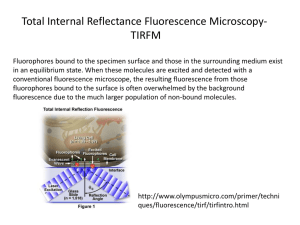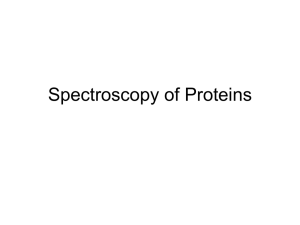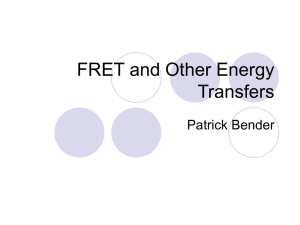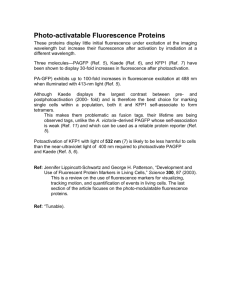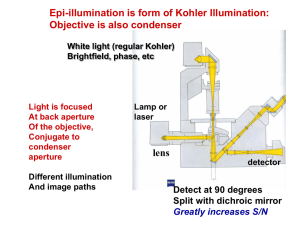METHODS - Nature
advertisement
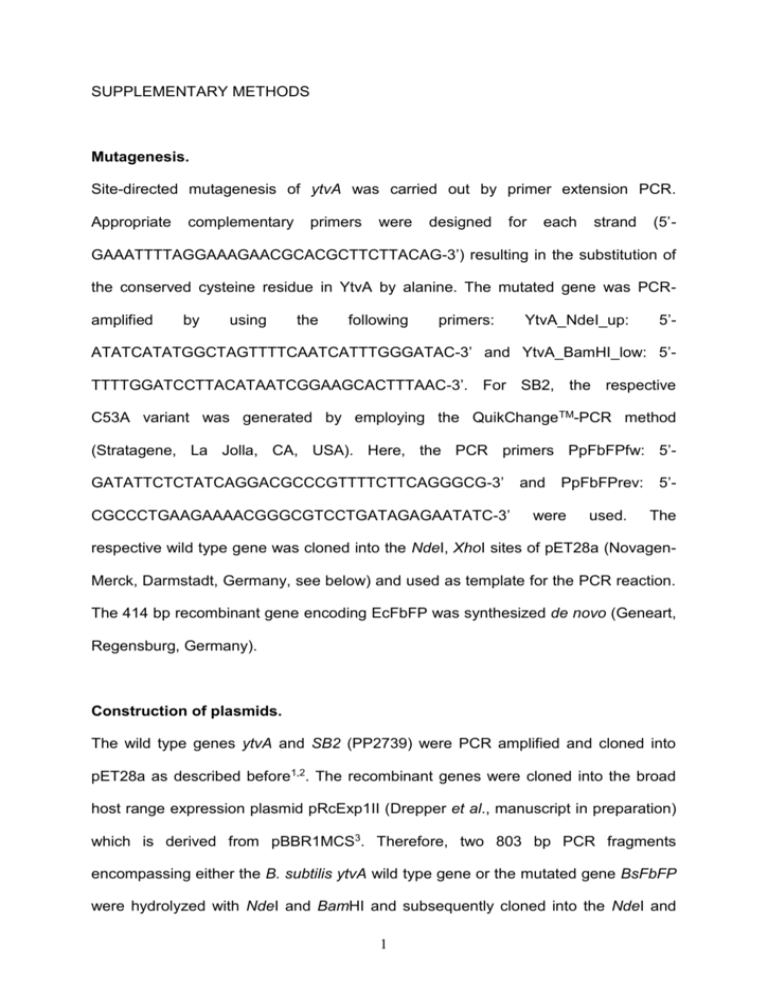
SUPPLEMENTARY METHODS Mutagenesis. Site-directed mutagenesis of ytvA was carried out by primer extension PCR. Appropriate complementary primers were designed for each strand (5’- GAAATTTTAGGAAAGAACGCACGCTTCTTACAG-3’) resulting in the substitution of the conserved cysteine residue in YtvA by alanine. The mutated gene was PCRamplified by using the following primers: YtvA_NdeI_up: 5’- ATATCATATGGCTAGTTTTCAATCATTTGGGATAC-3’ and YtvA_BamHI_low: 5’TTTTGGATCCTTACATAATCGGAAGCACTTTAAC-3’. For SB2, the respective C53A variant was generated by employing the QuikChange TM-PCR method (Stratagene, La Jolla, CA, USA). Here, the PCR primers PpFbFPfw: 5’GATATTCTCTATCAGGACGCCCGTTTTCTTCAGGGCG-3’ CGCCCTGAAGAAAACGGGCGTCCTGATAGAGAATATC-3’ and PpFbFPrev: were used. 5’The respective wild type gene was cloned into the NdeI, XhoI sites of pET28a (NovagenMerck, Darmstadt, Germany, see below) and used as template for the PCR reaction. The 414 bp recombinant gene encoding EcFbFP was synthesized de novo (Geneart, Regensburg, Germany). Construction of plasmids. The wild type genes ytvA and SB2 (PP2739) were PCR amplified and cloned into pET28a as described before1,2. The recombinant genes were cloned into the broad host range expression plasmid pRcExp1II (Drepper et al., manuscript in preparation) which is derived from pBBR1MCS3. Therefore, two 803 bp PCR fragments encompassing either the B. subtilis ytvA wild type gene or the mutated gene BsFbFP were hydrolyzed with NdeI and BamHI and subsequently cloned into the NdeI and 1 BamHI sites of the broad host range expression vector pRcExp1II to yield the expression plasmids pRcExp1II-ytvA and pRcExp1II-BsFbFP, respectively. Similarly, a 409 bp DNA fragment containing the synthetic EcFbFP gene and a 449 bp DNA fragment carrying the P. putida PpFbFP gene were cloned into the NdeI and XhoI sites of pRc-Exp1II resulting in expression vectors pRcExp1II-BsFbFP and pRcExp1II-PpFbFP, respectively. A YFP expression vector was constructed by PCR amplification of a 738 bp DNA fragment carrying the YFP gene using the primers 5’- GGAATTCCATATGGTGAGCAAGGGCGAGGAGCT-3’, introducing an NdeI site at the 5’-end and 5’-CGGGATCCTTACTTGTACAGCTCGTCCATGC-3’, introducing an BamHI site at the 3’-end. The PCR fragment was inserted into the SmaI site of pSVB104 resulting in pSVB10-YFP. Subsequently, a 722 bp NdeI-BamHI fragment from pSVB10-YFP was cloned into the NdeI and BamHI site of pRc-Exp1II resulting in hybrid expression plasmid pRcExp1II-YFP. Protein expression and purification in E. coli. EcFbFP and PpFbFP were overexpressed in E. coli BL21(DE3), purified and characterized as previously described for the wild type proteins1,2. For in vivo fluorescence measurements E. coli BL21(DE3) cells carrying pRcExp1II based expression plasmids were grown to saturation in LB containing 50 µg/ml kanamycin. The expression of the LOV genes was induced by addition of isopropyl-D-thiogalactopyranoside (IPTG) at a final concentration of 0.4 mM during exponential growth phase. R. capsulatus growth conditions and heterologous expression. The growth conditions, media, and antibiotic concentrations used to cultivate R. capsulatus 2 strains were as described previously5,6. R. capsulatus cultures were grown either on PY medium agar plates or as liquid cultures in RCV minimal medium. To grow R. capsulatus under strictly anaerobic conditions, cells were cultivated in gas-tight reaction tubes. Oxygen was removed by flushing the cultures with argon gas. Conjugational plasmid transfer from E. coli S17-1 into R. capsulatus via filter mating was carried out as described previously5. For in vivo fluorescence emission measurements the novel R. capsulatus expression strain R. capsulatus B10S-T7 was used which has been constructed to allow a T7 polymerase mediated overexpression of heterologous genes (Drepper et al., manuscript in preparation). R. capsulatus B10S-T7 carrying pRcExp1II based expression plasmids were grown in pre-cultures in RCV minimal medium until the late-logarithmic growth phase. Fluorescence reporter gene expression was tested with induced bacterial cultures grown to the stationary growth phase in RCV minimal medium. Western blot analysis. Immunodetection of LOV proteins was carried out with cellfree protein extracts of E. coli and R. capsulatus isolated as described before6. Proteins were separated on SDS-polyacrylamide gels (15% acrylamide) and subsequently blotted onto PVDF membranes (BioRad). Monoclonal GFP antibodies (BD Biosciences GmbH, Heidelberg) were used for the detection of YFP. YtvA and SB2 variants were detected with specific polyclonal antisera raised against purified wild type proteins (Eurogentec, Seraing, Belgium). 3 In vivo fluorescence measurements, fluorescence imaging of living cells, and spectrophotometric analysis. For qualitative in vivo fluorescence measurements E. coli BL21 (DE3) cells expressing the different LOV protein variants were grown until stationary phase in LB media containing 1 mM IPTG at 37°C. Samples of 1 ml culture of identical cell densities (OD580 = 1.6) were harvested by centrifugation and cell pellets were resuspended in 20 µl Tris-HCl buffer (0.5 mM, pH 6.8). Aliquots of 10 µl were illuminated with blue light (365 nm) and the in vivo fluorescence was documented photographically. Confocal laser scanning microscopy (LSM 510, Carl Zeiss AG Jena, Germany) was used for in vivo fluorescence imaging of living R. capsulatus cells. Cell culture samples were diluted in RCV medium to an optical cell density of OD660=0.5. Drops containing 5 µl of microbial cell cultures were placed on a microscope slide and illuminated with laser light of the wavelengths 488 nm (YFP) and 458 nm (PpFbFP), respectively. Fluorescence emission was detected in the ranges of 505 – 550 nm (YFP) and 475 – 525 nm (PpFbFP), respectively. Documentation was carried out using the LSM 510 Software, Version 3.2 SP2. Fluorescence measurements were carried out photometrically (Luminescence Spectrometer LS 50B, PerkinElmer, Wellesley, MA, USA). Defined aliquots from E. coli cell extracts or R. capsulatus cell cultures were diluted with 1 ml Tris-HCl buffer (100 mM, pH 8.0). Samples of 750 µl were used for photometric quantification of the fluorescence intensity. Samples were irradiated with light of 488 nm (YFP) and 450 nm (PpFbFP) wavelength, respectively. Fluorescence emission was detected at 529 nm for YFP and 495 nm for PpFbFP. Excitation slits were set to 12.5 nm and emission slits to 15.0 nm. 4 Fluorescence excitation and emission spectra of purified EcFbFP and PpFbFP were recorded using a PerkinElmer LS50B Luminescence Spectrometer at 20°C. The respective protein preparations were diluted to approximately 400 µg/ml in 1 ml quartz cuvettes with 10 mM Na-phosphate buffer pH 8.0, 10 mM NaCl. Protein-tochromophore ratio was determined by calculating UV/VIS (272/447nm) absorbance ratio as described before7. For the determination of fluorescence quantum yield, absorption spectra were recorded with a UV-2102PC spectrophotometer (Shimadzu, Duisburg, Germany). Steady-state fluorescence measurements were performed with a Spex Fluorolog spectrofluorometer or by using a PerkinElmer LS50B Luminescence Spectrometer. FMN purchased from Fluka (Neu-Ulm, Germany) was used as a standard to determine the fluorescence quantum yield of PpFbFP and EcFbFP, respectively. For quantum yield determinations the protein preparations were adjusted to an OD 447 of 0.1 with 10 mM Na-phosphate buffer pH 8.0, 10 mM NaCl. The molar absorption coefficient of free FMN at 450 nm (12,500 500 M-1cm-1) was used because a previous analysis of wild-type and mutant LOV proteins had indicated that the molar absorption coefficient of FMN in solution is identical within a tolerance of 10% to that of protein-bound FMN. The FbFP photobleaching properties were analyzed by diluting the protein samples with 10mM sodium phosphate buffer pH 8.0 containing 10mM NaCl to an optical density of 0.1 measured at 447 nm to ensure similar amounts of chromoprotein in the fluorescence samples. A blue LED (Luxeon Star, Lumileds-Phillips San Jose, CA, USA) with an emission maximum at 445nm was mounted perpendicular to the cuvette to illuminate the protein samples with an average light intensity of 2 W/cm2. Fluorescence bleaching was monitored at an emission wavelength of 495 nm. Time constants were calculated for a double exponential fit and represent the mean of 5 three identical measurements. The corresponding quantum yields Q were calculated according to the formula Q=1/(I x 445 x x ln, where I is the irradiation intensity of 2 W/cm2 converted to 0.75E-5 moles photons/(cm2 x s) and 445 is the extinction coefficient at 445nm (12,500E3 cm2 /moles protein). REFENCES 1. Losi, A., Polverini, E., Quest, B. & Gärtner, W. First evidence for phototropinrelated blue-light receptors in prokaryotes. Biophys. J. 82, 2627-2634 (2002). 2. Krauss, U., Losi, A., Gärtner, W., Jaeger, K.E. & Eggert, T. Initial characterization of a blue-light sensing, phototropin-related protein from Pseudomonas putida: a paradigm for an extended LOV construct. Phys. Chem. Chem. Phys. 21, 28042811 (2005). 3. Kovach, M.E., Phillips, R.W., Elzer, P.H., Roop, R.M. 2nd & Peterson, K.M. pBBR1MCS: a broad-host-range cloning vector. Biotechniques 16, 800-802 (1994). 4. Arnold, W. & Pühler, A. A family of high-copy-number plasmid vectors with single end-label sites for rapid nucleotide sequencing. Gene 70, 171-179 (1988). 5. Klipp, W., Masepohl, B. & Pühler, A. Identification and mapping of nitrogen fixation genes of Rhodobacter capsulatus: duplication of a nifA-nifB region. J. Bacteriol. 170, 693-699 (1988). 6. Masepohl, B., Klipp, W. & Pühler, A. Genetic characterization and sequence analysis of the duplicated nifA/nifB gene region of Rhodobacter capsulatus. Mol. Gen. Genet. 212, 27-37 (1988). 7. Losi, A., Ghiraldelli, E., Jansen, S. & Gärtner, W. Mutational effects on protein structural changes and interdomain interactions in the blue-light sensing LOV protein YtvA. Photochem. Photobiol. 81, 1145-1152 (2005). 6



